

 | ||
 | ||
Vol. 12 (1): June 2009 | ||
IUCN World Congress votes overwhelmingly for monk seal action |
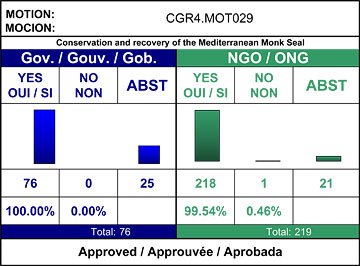 |
|
|
IUCN has also published the final, official text of the resolution [4.023 Conservation and Recovery of the Mediterranean Monk Seal Monachus monachus, PDF  20KB], which calls upon all Mediterranean countries to “maintain and increase their efforts to aid the recovery” of the species.
20KB], which calls upon all Mediterranean countries to “maintain and increase their efforts to aid the recovery” of the species.
As noted in our November 2008 issue [IUCN resolution calls for monk seal action, TMG 11(2): 2008] the resolution recommends the following specific measures:
The resolution also calls upon the IUCN Director General to:
Despite encouraging comments by the Pinniped Specialist Group Chair, Kit Kovacs, carried in our last issue, to the effect that the “PSG will be helpful in ‘progressing’ conservation action with this species”, it remains uncertain at best how such progress might be realised.
Through its monk seal specialist Alex Aguilar, the PSG has since voiced irritation that it was never consulted on the drafting of the motion for a resolution, as well as a reluctance to actively pursue its implementation.
Somewhat ironically given its lament over perceived lack of consultation, the PSG did not respond to several written requests by The Monachus Guardian to provide specifics on how it might advance the monk seal cause, either through the resolution or outside of it.
The Barcelona Congress, according to IUCN, attracted some “8,000 of the world’s leading decision makers in sustainable development: from governments, NGOs, business, the UN and academia; together in one place for 10 days: to debate, share, network, learn, commit, vote and decide. The objective: ideas, action and solutions for a diverse and sustainable world.”
Indeed.
IUCN. 2009. 4.023 Conservation and recovery of the Mediterranean monk seal Monachus monachus. Resolution, 4th IUCN World Conservation Congress, Barcelona, 5-14 October 2008: 1-2. [PDF  20KB]
20KB]
IUCN SSC. IUCN Species Survival Commission Specialist Groups.
Thirty-eight participants from 12 countries attended the Mediterranean monk seal workshop in Istanbul on 28 February 2009, including field researchers from the core population centres of the species. Held as an adjunct to the 23rd Annual Conference of the European Cetacean Society, the Workshop’s focus was a narrow if complex one: can a standardised approach, using photo identification techniques, be established internationally to provide a reliable estimation of population trends and abundance?
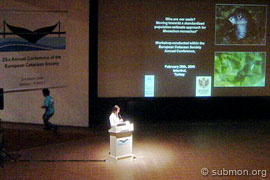 | 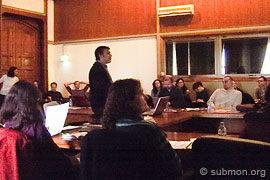 | |
| Dr. Giulia Mo, co-organiser of the workshop, during the presentation of the results at the ECS congress. | Dr. Manel Gazo of Submon, Spain, describing photo identification techniques previously applied in Mauritania. |
At present, no standardised or even compatible methodologies for estimating population numbers are applied by the various groups involved in Mediterranean monk seal research and conservation. While there may be broad agreement on the theoretical benefits of devising such an approach, perceived practical difficulties have often stymied such efforts. These range from differences in habitat occupied by monk seals (that might favour photographic data collection in one area, such as the concentrated population at the Coast of Seals, Mauritania/Western Sahara, while proving far more complex and expensive in areas where the monk seal population is more fragmented, such as in Greece); to concerns that a scheme of this kind would prove so time and resource consuming as to divert attention away from more urgent priorities.
The Workshop [Who are our seals? Moving towards a standardized population estimate approach for Monachus monachus], organised by Prof. Ali Gücü of Middle East Technical University, Institute of Marine Sciences and Dr. Giulia Mo of ISPRA, Italy, was conceived as a means to kick-start international discussion on such methods, while providing participants an opportunity to share their field experience in photo ID methodology and related technical issues.
“We believe this is an important issue,” says Ali Gücü, “because although it is commonly agreed that the Mediterranean monk seal is endangered and approaching the verge of extinction, the estimates available in the scientific literature are still not comprehensive enough to give a meaningful picture throughout the distribution range of the species. The presence of colonies and reproductive activities may be known for some regions, and at a very local level there is also evidence of stable or apparently increasing pupping rates. Elsewhere, however, there are recent sightings of seals at sites where the species was considered extinct, but little can be concluded on these individuals’ site fidelity, habitat use and displacement capacity. How do we know that the monk seal population in the Med is not actually decreasing? We think that without answering these questions we will have difficulty in sustaining any further conservation action, for example in establishing protected areas, fisheries regulation, socio-economic initiatives etc.”
While photo identification has long proven successful in Mauritania/Western Sahara, allowing researchers to gain an understanding of the mobility of individual seals, as well as to draw hard data on population levels, researchers in other areas believe that such data, even if it were possible to collect, might not necessarily end up aiding the conservation of the species.
Dr. Alexandros Karamanlidis, a researcher representing Greek NGO MOm, an organisation with almost twenty years’ experience in this field, expressed concerns over the feasibility of implementing reliable mark-recapture studies on the species in the eastern Mediterranean.
Evaluating the long-term efforts of the society in monitoring the monk seal, many of which have included the deployment of remote monitoring systems, he suggested that priority should instead be given to assessing the birth rate of pups in such areas.
Sharing a similar view, the Turkish monk seal organisation SAD-AFAG has stated that it does not regard photo-identification to be a conservation priority at the present time.
Despite such differing views, the Workshop generated some signs of progress in having the methodology adopted elsewhere.
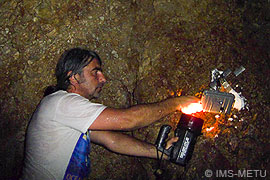 | |
| Ali Gücü, installing an automatic camera in a seal cave. |
With the financial assistance of RAC/SPA (the UN body responsible for implementing the Mediterranean Monk Seal Action Plan of the Barcelona Convention), Cyprus and Libya are to deploy camera traps this summer, according to information received by TMG. The programme will draw on the technical experience established by METU-IMS over the past two years along the Mediterranean coast of Turkey and northern Cyprus, where 20 traps have been installed in identified seal caves. The camera traps set for Libya will be installed in a joint collaboration effort between EGA Libya and ISPRA, Italy.
An additional 10 cameras will be provided to METU-IMS by RAC/SPA to expand its programme. Photo-identification, says Ali Gücü, will allow the preparation of a seal catalogue for the area, while applying mark-recapture methods will begin the process of assessing actual population size.
RAC/SPA will provide the necessary equipment on loan through national focal points, with the possibility of the camera trap programme being expanded to other Mediterranean countries at a later stage.
Nine presentations were made at the Workshop; we hope to make summaries of these available in our next issue:
Conclusions of the Workshop, as well a summary of participants’ viewpoints can be found in the PDF listed below.
Gücü, A.C. and G. Mo. 2009. Who are our seals? Moving towards a standardised population estimate approach for Monachus monachus. Workshop conducted within the framework of the European Cetacean Society Annual Conference [an event sponsored by RAC/SPA (Tunis) and Pelagos-Monaco (Principality of Monaco)], Istanbul, Turkey, 28 February, 2009: 1-5. [PDF  162KB]
162KB]
Espai Submon. International workshop on monk seal within the Annual Congress of the European Cetacean Society, 5 March 2009.
|
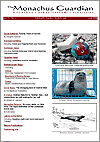 | |
Thanks to the support of the Government of the Balearic Islands, the June 2008 issue of The Monachus Guardian was published in Spanish in early February.
If you have Spanish-language friends or colleagues who you think might be interested in the publication, please let them know.
The Spanish translation can be accessed at www.monachus-guardian.org/spanish or through our “home” page www.monachus-guardian.org.
The Monachus Guardian is now publishing a Wordpress news blog, specifically designed to deliver breaking news updates between the summer and winter issues of the journal. Those using news reader software may also subscribe to the blog’s RSS feed. If you have monk seal-related news, images or video you would like to submit for publication, please contact the .
The Monachus Guardian has also established its own Web 2.0 presence on Facebook.
Like the news blog, the TMG Facebook page provides a convenient platform for delivering rapid news updates between issues of the journal, and visitors will note that in recent weeks we have uploaded news, photos and video of ‘Artemis’, the orphaned monk seal pup that underwent rehabilitation at the MOm Centre on Alonissos prior to her release in April; monk seals congregating on open beaches in Mauritania/Western Sahara; recent sightings in Croatia; and various linked news reports from Hawaii.
You do not need to be a member of Facebook to access the page — although you will to comment on news stories, or to contribute to any future online discussions.
Becoming a ‘Fan’ of the page will also help spread the conservation message further and wider through Facebook and beyond — please consider it if you are already a FB member.
Those using RSS news reader software may also subscribe to The Monachus Guardian Notes blog.
 | |
|
| |
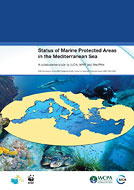 | |
|
|
We take the opportunity of alerting our readers to the following publications on marine biodiversity, protected areas and broader conservation issues.
IUCN. 2004. The precautionary principle in biodiversity conservation and natural resource management: an issues paper for policy-makers, researchers and practitioners, by Rosie Cooney. IUCN Policy and Global Change Series No. 2: 1-65. [PDF  433KB]
433KB]
For those pondering ex situ conservation measures with scant attention to consequences or philosophical issues, this is an excellent companion to the publications recommended in our June 2008 issue, on applying precautionary principle guidelines, and on captive breeding.
IUCN, WWF and MedPAN. 2008. Status of marine protected areas in the Mediterranean Sea, by Ameer Abdulla, Marina Gomei, Elodie Maison and Catherine Piante: 1-152. [PDF  3.15MB]
3.15MB]
More recently, IUCN, WWF and MedPAN have collaborated to publish a status report on MPAs in the Mediterranean. The MedPAN website, meanwhile, now features an updated inventory and searchable database of MPAs within the Mediterranean.
Barcelona revisited
“They used to live near Barcelona, and of course the conservation groups moving this [IUCN World Congress] motion are smart enough to mention it – as though we can gaze over the harbour at the Mediterranean blue and imagine the seals’ heads bobbing above the wavelets.
What can be done? Coastal development of many types seems to compromise the seal.
And as coastal development along Europe’s favourite holiday coastlines is hardly likely to stop, more marine protected areas are the favoured outcome.
IUCN motions don’t make governments do things. But the organisation talks regularly and directly to governments, and carries more weight in governments than NGOs.
If these motions go through, it will put a little more momentum into schemes to keep these species in existence.”
Richard Black, Congress Diary, BBC News, 15 October 2008.
Peace With Seals
 | |
|
|
The Czech film-maker Miloslav Novak has been on a very different journey: to find a creature we are killing. The Mediterranean monk seal is Europe’s most endangered species. After 14 million years dappling in our seas, there are fewer than 500 left in the wild, and none in captivity. These odd, wriggling, blubber creatures, with arms like men and snouts like pigs, are about to pass from history. In most wildlife films, the camera is a god, swirling anywhere the wildlife swirls. Not here. In Peace With Seals, Novak has made a wildlife film about his inability to find any wildlife. He trawls Europe trying to find the seals. He tries to lure them with large plastic replicas of female seals, the amphibian equivalent to sex dolls. He interviews elderly seal hunters. But he only ever gets fleeting glimpses of the creatures themselves – and then the seals are gone.
The film becomes a meditation on the great ecological die-off we are living through – and causing. The seals are a seal on our fate, too, he believes. He quotes one of my favourite novels, Karel Capek’s The War With the Newts, where humans and amphibians go to war.
If this is a war, we have won. Wildlife has lost. And we will pay for our victory. The film ends with a hellish image. In the 1950s, a seal was captured in Sardinia and brought to Rome, where it was made to live in a fountain. Novak imagines the animal flapping in concrete while photographers burst flashes in its face and a crowd of tourists roared its approval. This is what the world looks like now, on a grand scale.
Sheffield’s documentary festival: Reflections in a dark mirror. Reviews, Films, The Independent, 11 November 2008.
Note: Miloslav Novak’s film, Peace With Seals, a 12 Opic and Panda Film production, has received several nominations and awards at recent international film festivals. While its quirky, avant-garde style represents a stark contrast to traditional wildlife documentaries, the film features fascinating archive footage – including the capture of the famous Sardinian pup that ended up in the Piazza di Trevi fountain in Rome – as well as interviews with former seal hunters.
EndQuoteEt tu, Monachus? Both seals learned to highly accurately identify a lodestar out of a pseudo-randomly oriented, realistic projection of the northern hemisphere night sky. Providing the first evidence for star orientation capability in a marine mammal, our seals’ outstanding directional precision would allow them to steer by following lodestars of learned star courses, a celestial orientation mechanism that has been known to be used by Polynesian navigators but has not been considered for animals yet.
|
  Copyright © 2009 The Monachus Guardian. All Rights Reserved |